A Series of Unfortunate Succulents
This past couple of weeks has been a rough for both, me (work) and my plants, probably due to the neglect from my care or too much care over the long weekend holiday.
As a grower, we will encounter good days, where everything you do seem to be on the right track and everything just fall into place - likewise there are also bad days where you nothing seem to work out but only failing plants.
Unfortunately for me, I would like to share those bad moments and hopefully you could post some of yours here too. And fortunately for those who can learn from our mistakes and become better growers.
1) I've believe this is my first time killing a succulent by over-watering. I must admit, I was rather heavy handed on my watering late last week due to the hot weather, and the constant sunshine these plants have been getting in the community pot from the roof. All plants shows signs of thirst, so instantly I've been watering the pot almost daily.
Returned home one day and something seemed amiss when I started seeing the crown turning slightly yellow. Gave it a tug, the rosette began to fall apart. Pulled the whole plant out, the roots were mushy and probably had rotted for a day or two - and has already reached the crown. Nothing more I can do but learn from this painful lesson in watering. I had stopped using my weighing method because I thought I was getting better at this. One thing for sure, is that it's definitely much harder to meet the needs of each individual plant when planted in a community pot.

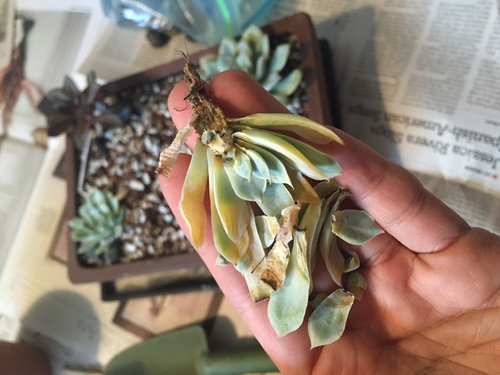
2) Sunburnt E. PvN (variegated)
My Perle von Nurmberg has been encountering stress conditions since the day I repotted it, and I've learnt from Laurent that this plant doesn't do well with much direct afternoon light, hence the extensive sunburnt.
Planting it in a community pot was probably a mistake to begin with as the rest of the plants were thriving with more prolonged sunlight.
As the burnts got worse, I bit the bullet and repotted it into a smaller pot Recalling from the last time I transplanted it, it had very little signs of roots and this time, it was an extensive mass intricate root system. I didn't manage to snap a quick photo, but I'm relieved it's roots are established and it's on a slow road to recovery.


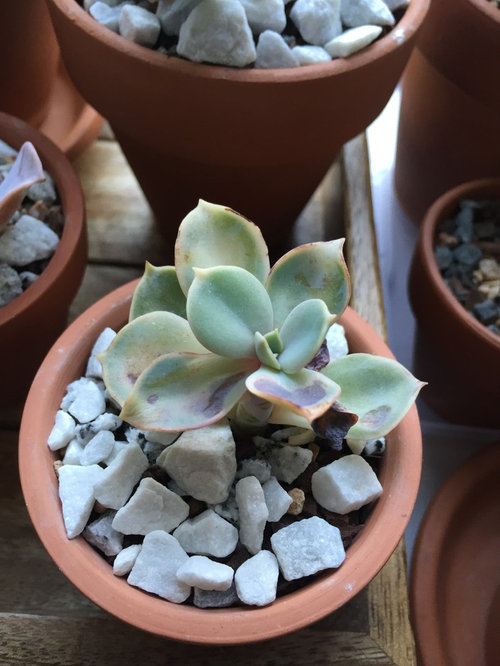

3) Variegated E. Imbricata from Altman's
This was probably my most heartbreaking purchase, opening a package to see a fragile variegated Echeveria buried in moist peat soil due to poor packing and handling on the seller's end.
I did get a refund, but it still absolutely broke my heart to see such a frail and weak plant just fall apart despite me giving it the best care to try and nurse what ever it that had left.
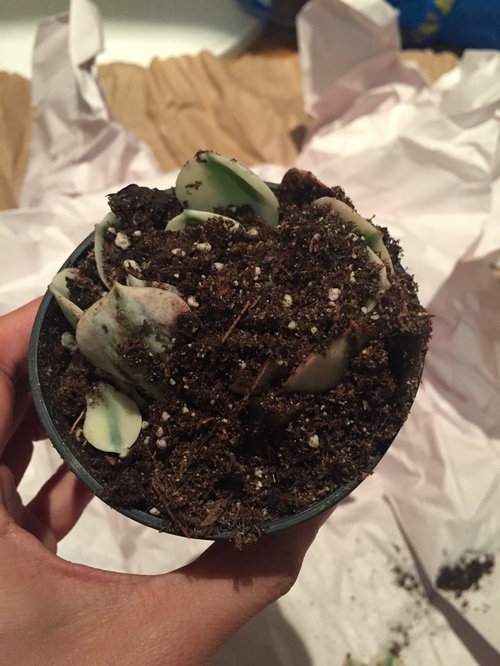

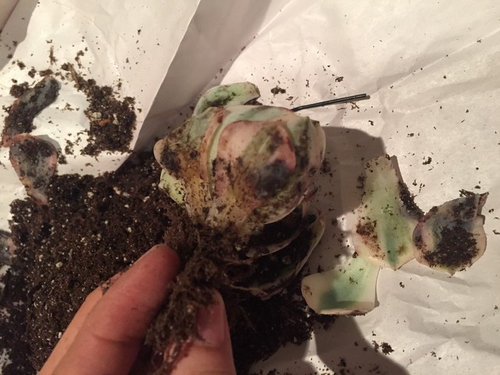
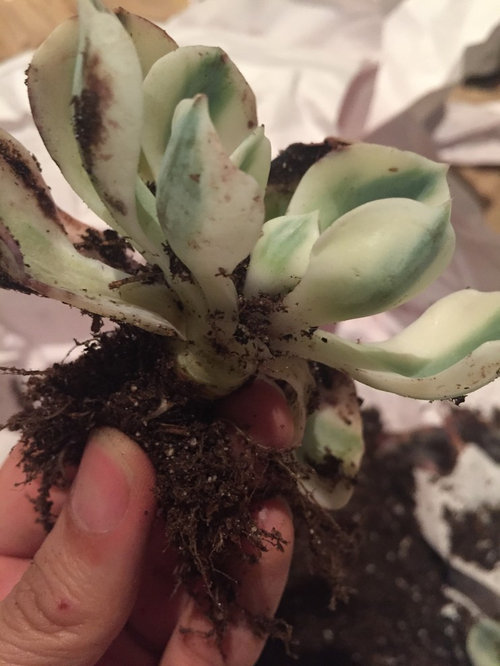
Comments (73)
bernardyjh
Original Author8 years agolast modified: 8 years agoNope, unless the weather it's really terrible and we switch it on for the night. For the most part in the day, we are out of the apartment (at work), so it's warm and humid - fungus paradise. I try to leave the fan on, but it only helps that much..
I saw a post on some jades grown in complete turface, so I'm going to test this theory. So far it's been only 2 plants that are potted in this new mix.
Echeveria Agavodies 'Ebony'
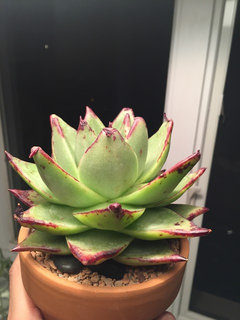
Jade 'Hummel Sunset'
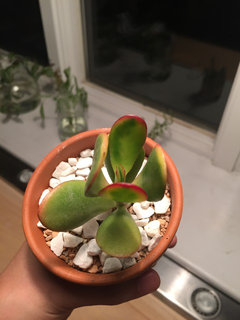
Neil
8 years agoBernard- You know that I know..how the electric bills in NYC are. I've paid Con Edison and Brooklyn Union Gas hundreds of dollars a month and not only in the summer. I used to run the AC all the time though. Don't give up! Had I known at the time..I would have gotten a dehumidifier. I have never used one before but, I think they're less expensive than running the AC all the time. My friend Dina in Manhattan has a rooftop garden with succulents which is not enclosed. When it gets cold she brings them all indoors and she uses a dehumidifier even in the winter. Hopefully there are other east coasters on the forum who could offer better advice. Start a new thread maybe? "Calling all East Coasters," like I did with the jades.
Hang in there B!
Related Discussions
Which to buy-Lawn boy M series or 1974 LB d400 series
Q
Comments (16)"Curiouser and curiouser. We have read for years on here that the 16:1 was because of bushings rather than roller bearings, now it's no longer true. Okay, then what is the reason for 16:1 (I have no idea why I care, since I will never own one)?" You will note that I say the BOTTOM bushing. The D400 had needle bearings on the top end. The switch in mix spec came when they went to the 2 ring piston AND the needle bearings on the wrist pin end of the connecting rod, perhaps this was the bushing others were referring to which you may have misinterpreted. These parts can be interchanged and I have done it often only the connecting rod with needle bearings on the wrist pin end must be used with the 2 ring piston. As for never owning one, reminds me of someone I know who says he will never own a Ford. Surely most people know that the bottom bushing continued thru the D600 series which used 32:1 mix and all of these LBs had the mix written on them though in early years it was a decal which eventually became illegible. Some had the mix molded into the shroud. I would note that there is a difference between "needle bearings" and "roller bearings". LB, until DuraForce, used needle bearings unless it was the "M" with which I am not familiar. As I have said before on this and other lists, if you are uncertain what mix you should use, clean your exhaust ports and while you are at it, count how many rings are on the piston as you look thru the clean exhaust ports. Three rings = 16:1, 2 rings = 32:1. Walt Conner...See MoreHelp deciding on Andersen 400 Series vs 100 Series Windows
Q
Comments (11)Thanks for pointing out I wasn't clear on which Andersen line. It was the 100 series windows (I updated the post to clarify- thank you). I saw a sample on the floor of a window store where the sample was probably around 36"w X 48" tall. The frame didn't stand out as large. Unfortunately, most of my windows are narrower but the frame size is always 3". For example, I have 2 casements with a transom above (3 windows mulled together) where each casement in the pair is 24"w X 42"h - so the middle of this complete window is 6" of frame and the sides are 3". of frame.. that left only 18" of glass showing on each side with this 6" glob down the middle. Similarly, the transom across the top of the 2 casements is 48"w X 18"h and fully 1/3 of the window (6" of the 18" height) is frame - only 12" glass....See MoreCriminal to mix Andersen 400 series with some 100 series?
Q
Comments (12)I did mix them all throughout the house (my window style is a cottage 4-over-1 grid with both interior and exterior grids), and after all my fretting, no one would ever be able to tell from the inside or outside! (I even have to look and try to remember whether some of the casements are 100s or 400s.) If it weren't for needing some very specific sizes (and wood grids to stain in our den), I would do all 100's because I cannot tell the difference in terms of operation/quality on the casements and you can barely discern the difference in terms of looks. And even in rooms where I chose the 400 series because I wanted to have double-hung windows, I wouldn't do it again....as appealing as the notion of being able to open the upper or lower sash was, what I've found in day-to-day living is that I only ever open the bottom sash, so I would've been just fine with simply doing single-hungs! Overall I'm satisfied with my Anderson windows, but I like my friend's Marvin Integrity windows better than mine--hers operate better and just have more of a "quality" look (mine still look fine.....I was actually going to do Integrity originally, but they did a price-hike during construction, and I just couldn't justify the extra $15-20K). I will say, however, that my Anderson 100 sliding windows that I did in the basement are ATROCIOUS in every way. Incredibly difficult to lock (you have to slam the window shut in order for the locking mechanism to "catch"--I far prefer the manual latches I had on my previous sliders), don't slide open very smoothly, let dirt in (we live in a very windy climate but still I've never seen so much fine dirt piled up on a window ceil!), super cheap--the lock plates have snapped or broken off over half of them in just the first year (and we almost never even use them). Needless to say, the inexpensive vinyl sliders we had in the basement of our last house were far superior....See MoreLife Line Series, Contour Shower Seats
Q
Comments (0)My wife is having knee replacement surgery and I want to install a fold up shower seat. Unfortunately, the shower is of the molded one piece acrylic type and in the area where it needs to be mounted, there is about an inch of dead space between the shower wall and the wall framing. The only way I can think to safely install the seat is to open up a small section of the wall on the other side (drywall) and install wood blocking that gets the correct spacing and butts flush with the back of the shower wall. Any other ideas would be welcome. Thx....See Moreaztcqn
8 years agoHi Bernard, Hang in there. Leaves, sometimes, can take a while to grow roots... As long as the leaves remain plump there is a good chance.
In my experience stem cuttings are easier to root. Can root without medium if they get bright light.Laurent - French Riviera (zone 9a)
8 years agoBernard, you should remove the gravel on the surface of the soil. Let the soil breath. The gravel is like a cork keeping humidity and fungal diseases at the level of the roots.
Sugi_C (Las Vegas, NV)
8 years agoBernard, something is wrong with either your mix or the way you water. I'm going to out on a limb and say it's both.
First, the Turface in gritty mix is the most water retentive thing in there. I can see in the leaf cuttings shot that your Turface is soaked through, and leaves without roots need no water at all. I can lay mine on a table and it will root -- which doesn't mean your variegated leaves will root, too, but you definitely do not need water.
Second, gritty mix--or learning about gritty mix--and trying it should change the way you grow things. I'd assuredly say that at least 90% of my plants starting from about 20 years ago, I eventually killed with "love" (aka water). But it was hard to see that until I used gritty mix. That said, using gritty mix is not permission to water to death. I've since taken Al's information and advice and changed it to meet my needs because (1) I have sprinklers I cannot control; (2) I water, fertilize and do as I please; and (3) the soil has to adapt to me, not me to the soil.
Third, it looks like you are growing indoors. There is virtually nil chance, short of you living in a greenhouse, that your plants are getting too much sun even in a southern window. Many of these plants thrive in outdoor full sun with moderate temperatures (definitely hotter than the temperature you live in, I presume) in their natural habitat or in our gardens, so inside your house, if the leaves are getting scorched, I'd guess it's because something else is wrong. Add direct sunlight to an already ailing plant and yea--something will most definitely go wrong.
Some of your plants are "opening up" which, to me, usually means one of two things: either it's extending its arms for more light, or it's drowning.
Just as reference, even using my variation of Al's mix, I water my indoor plants about once every 10 days in the summertime. The ones I have in areas with anywhere from 1-5 hours of sun outdoors in blazingly hot Stockton, CA, haha -- I water every 2-3 days. I have a little more leeway because I've adjusted GM to be so loose and big. I'm going to bet that you water yours more often than that, and your mix is most definitely wetter than mine is as mine has no Turface and virtually nothing that can actually "absorb" water except in pockets and crevices of the lava rock and perlite. I could STILL overwater it, though, Bernard. It's less likely in gritty mix -- yes. It's not impossible!
Here is a huge pot of jade cuttings I have -- no roots, or perhaps just starting to form, and the large cuttings are propped up by big rocks. After about 10 days, I've just watered it for the first time yesterday...though as you can see, it doesn't look wet at all. But I guarantee you if I flipped over the pot and dumped all of its contents, the mix is perfectly wet below. Moist -- not soggy and absolutely no standing water.
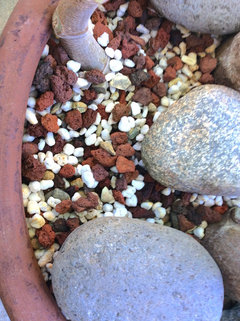
So, all that just to say that just because you use GM doesn't mean bad things will not happen. But once you realize how little water these plants actually need--you can then easily grow in virtually any other mix. In a hundred years, I would have never realized that fact on my own if not for trying this mix of rocks and bark, haha -- if the top looks dry, I'd water! It was the logical thing to do, but seeing as how these plants thrive in nothing but rocks and perlite, it becomes crystal clear that my other plants in Pro-Mix or any potting mix need so much less water than I would normally provide. I have a few pots where I have succulents or cacti in ProMix and I don't water those in the garden for about 10 days!
It isn't concerning at all that until you figure out what works for you, things may go wrong. But what is concerning is that even when you discover that something is amiss and you fix it, it's not working or the plant isn't recovering.
Take the one on the right, for example (ignore the one on the left)--a case of something having gone miserably wrong:
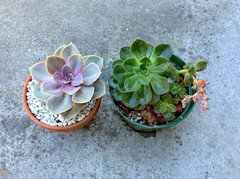
I don't know the name of it and don't actually care, haha, but it was the one case where I found mealybugs. It was in the back of a grouping and the plant looked fine from atop--but clearly I had not checked closely enough. YUCK. So I took it out of its pot, washed the roots to kingdom come, chopped up the entire plant into several pieces and threw away the chunk in the middle with evidence of any white gunk. Then I stuck them all back into a newly made gritty mix a couple of months ago and voila, they are fine. Of course, this sits outside in partial sun and as mentioned, it gets watered every 2-3 days at best in 90 degree weather. I'm sure it could go longer, but in a good mix, it doesn't have to. But if I had this indoors in my house, then I'd water it once every 10 days.
Or this one, which I burned to hell when I first moved in:
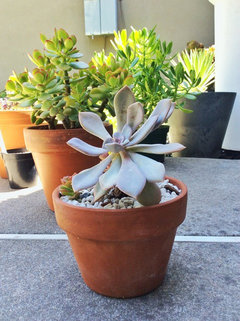
I tore off all of the obliterated leaves and have it in a much milder sun, not against a light colored wall. But it WILL recover and grow new florettes and look wild in no time.
Or take this one, for example--and keep in mind how much more water a pepper needs compared to succulents:

Now, I'm not certain I could manage a tomato in gritty mix but peppers -- no problem. Once a day or every other day depending on temps, I give it a dump of of regular water or fertilizer water and it has no issues. Granted, if we hit over 100, I take it out of full sun and put it in the shade. A day or two of shade never killed any plant though cooked roots would, right? But if a pepper can grow in gritty mix, this should indicate to you that gritty mix does hold enough water. And keep in mind this is GM without Turface -- looks like this one I made with lava rocks, perlite, pea gravel and bark. Clearly, I have no real recipe, LOL -- I think I just used some leftover mixed stuff together.
As I suggested in my first response, if I were you, I would definitely let the ailing ones recovering in pure, screened perlite only--not Turface. I know firsthand that growing in Turface is more than possible and I've even tried growing seeds in it successfully after seeing Josh do it--but if you're overwatering, Turface only will make things worse. Furthermore, if you do it for the longterm, Turface breaks down and when you want to repot it, you're in for a world of hurt if it doesn't have equal amounts of grit and bark in there to help keep things apart. Pure perlite, water infrequently (especially if your place is humid!) and wait it out without doing anything else.
If you doubt it, take a sprayer with only water and spritz 6 ounces of it into a small pot full of Turface inside a bowl, very slowly in small sips. Do the same with an identical pot full of perlite. After 30 minutes, lift the pots out of the bowl and let it drip, then measure how much water you have left in the bowl. I guarantee you that you will get more water come out of the perlite than you will the Turface--significantly--which tell you how much water Turface can hold. That's a good thing--except in the case where you overwater like I am prone to do. Given how attentive you are to your plants and how much effort you are putting in, I'm going to guess that you, too, are more prone to overwatering than under-watering.
Hope that helps! Hang in there!
GracePlantspace (5a)
8 years agoOh one thing I wanted to mention here with the cinnamon on the cuttings,
I've noticed many problems using this as a long time orchid grower. Anytime I've used cinnamon powder on
cutting of roots/rhizomes/leaves- no new growth comes from that area
ever again, everything just stops. So cinnamon might be part of the problem. While
I recognize you want to prevent rot/fungus/etc from spreading, maybe
look into sulfur powder (which some cacti growers use), or a gentle 1% hydrogen peroxide rinse, let the plant
dry up for a few days/week, then repot. Also some plants dont take
repotting lightly and will show signs of stress for awhile before
bouncing back. Its frustrating when you're trying to do everything you can to make plants feel comfortable in their new home, but wont work with you. Maybe try a different approach, it might just work :)bernardyjh
Original Author8 years agoNeil - will note on the dehumidifier idea, but essentially we only have a few short months of heat and humidity before it gets all cold and dry again.
Esmeralda - Have you ever have success with rooting cuttings that have been coated cinnamon powder? It is great that it is a natural fungicide, but I'm really afraid it forces the plants to seal up the meristem and the plant has stopped trying to produce roots - that's my concern. I tried to wash off the cinnamon powder the other day, but the stem just seems to be orange and won't come off.
Laurent - Excellent point, will do a clean up and remove all the gravel top soil tonight.
Grace - I really appreciate your detailed write up and shared experience. It's a lot of information to process at once, let try to address them one by one.
I'm definitely trying to figure out the balance in my watering frequency, especially where it has gotten alot more warmer lately, I figured I need to up the intake of water to help the roots coop with the heat. I take it a very personally when I feel like my plants show signs of thirst -- like this past scenario where I severely underwatered my plant.
I think my first mistake was to up my frequency to water since the temperature is hot, as my twice a week routine during the spring worked out perfectly fine for my plants and they thrived in it.
1) I tried to rinse all the fine dust particles with water, and I haven't gotten time to dry the mix before laying the leaves - so I have to correct that.
2) I'm totally on the same page on how the soil should match our growing habits and not us to the mix. As my collection is slowly growing, I find it exhaustive to water them constantly every other day, and to increase the difficulty to gauge, I have established plants in community pots as well as individual pots, newly acquired plants and younger seedling plants that needs watering more frequently so that their roots don't dry up and die. So perhaps, planting younger plants in turface mix will help balance out the need to increase my watering frequency.
I'm considering getting perlite for ailing plants that I need to encourage root growth.
3) My apartment gets access to the roof and I move the more established plants up as much as I can given the chance - that increases my complexity in keeping track too, as the ones that gets sun show signs of thirst much quicker, and usually when I water them, I do for the rest of the other plants that just sit on my windowsills.
So far I have about 20-25 different type of plants and not all of them are dying/struggling as the ones shown in this post, some in fact are already producing offsets and are showing nice coloration and are thriving in the GM with my heavy handed watering. I believe the toughest fact to swallow is that every plant has different needs and the tweaking part needs more work on my end, but it's frustrating and I don't know how to start.
MintyLemonade - I think you are on point here, what do you think I should do to those that are already coated with cinnamon? Soak them in water or cut the stems further?
I'll take your advise your and get some sulfur powder instead of using cinnamon.
Thanks for all your encouragement guys, I believe it's hard to practice tweaking on my watering practice when we have such extreme weather changes in our environment in the East.
Plantspace (5a)
8 years agoHonestly I dont know if introducing more water at this point is a good idea :/ ... I would brush off as much of the cinnamon as possible and wait till its calloused over before introducing anything else.
Just stumbled upon this article, it might be of some use
http://www.kadasgarden.com/Crot.htmlaztcqn
8 years agoBernard, a big YEP. I believe sulfur is stronger than cinnamon and where I apply it,it shuts the wound right up. I would just leave the coating on the ends. A succulent is capable of putting out roots other than the end of the stem. What usually happens is roots form along that length of the plant (soooometimes on the cut end) and eventually sends up pups where the roots appear.
ewwmayo
8 years agoI've been encountering the same thing with watering my plants! Moving them inside and outside on different days really changes the water requirements, making watering tricky. It just takes a lot more time and effort.
Now that I'm keeping most of my plants outside always (except during storms), watering has gotten easier. Finally figuring out where to put each plant, how much to water, and if the outdoor light is too strong (1/3 of them are now staying indoors permanently).
For indoor mixes, I doubt I'll be using bark at all anymore. With grit and perlite, maybe a smidge of soil, I think I get a mix that can easily last more than a week between watering. My indoor grow area gets a fair bit of air movement and temperature swings between 22C to 35C (72F to 95F).
LilBit7765
8 years agoBernard, when I switched to gritty, I had 3 or 4 HEALTHY echeveria black princes. In the VERY begining they didnt even skip a beat, but after about 2 or 3 months, thats when ALL H3!! broke loose! They are in a 1*1*1 of turface, grit, and repti bark. I had one MASSIVE one, who actually in the end, sustained the most damage. You're getting good advice, but I wanted to share with you my experience so that you hopefully can learn from my mistakes. Listen to sugi!! :)
Mine started turning around when I DIDNT water very often at all. Mine were kept in a south window with unobstructed light. The bedroom only had a window shaker for a/c. (It was only on at night and very few days) There was a ceiling fan that was on high at ALL times. But i honestly had to REFRAIN MYSELF FROM WATERING THEM lol! I would let them go for two weeks (sometimes a few more days) they are very thick leafed succulents, so they typically need less water in my experience. I just wanted to tell you what worked for me. One plant literally only had 4 or 5 leaves left. Maybe use a wooden dowel or scewer to help you gage the moisture in the pot? Our fingers are usually tough skin so theyre not as sensitive to the dampness in the gritty. Also i picked up another one this season with SOME varigation, and its in some soil with 75%perilite in full sun doing great. Sugi is right, it'll get easier for you as times goes on just hang in there. We've ALL unfortunately killed our fair share of plants and STILL have that oopsie now and then. I know it sucks but just try to learn from it and not beat yourself up about it, even though I know its hard.
bernardyjh
Original Author8 years agolast modified: 8 years agoMintylemonade/Azt - I bit the bullet and took your advice, scraped the dried parts last night.
Here they are, don't have the chance to grab sulfur powder yet. For now, I'm just gonna fuss less over them and I'll let the wound callous over and heal up aside on the tray.
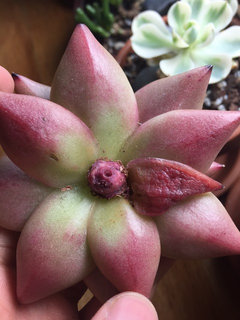
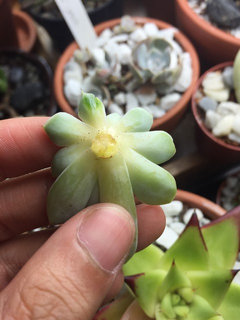
bernardyjh
Original Author8 years agoMayo - Things got really trickier when the temperature rises. Compounding with the micro attention needed to newer plants that have been repotted. I'm working towards eliminating the bark element in my mix too, I often find the rate of moisture absorption by the bark in my mix inconsistent. I'm afraid some of them might have turned hydrophobic.
Lilbit - Thanks for sharing, I'm definitely going easier on the watering hand now and evaluate my point of actions. My weighing scale and tracking log is definitely coming back out now before I water my plants.
In the mean time I'm really intrigued by Grace's perspective by propagating/aid stressed plants in 100% perlite. I'm gonna keep at the research then make the purchase on perlite and pumice altogether.
Sugi_C (Las Vegas, NV)
8 years agoOh, just saw your post before my reply.
I'll disagree there, too, haha!!
If anything in your mix is presenting the problem with your watering habits, it's the Turface because it's the most water-retentive ingredient in there. If the bark is hydrophobic, which it can be occasionally but really, not in your circumstance where the mix is watered so frequently (assuming you pre-soaked the bark), but if it were, it's a good thing here. That said, I've no idea what kind of bark you are using.
And the perlite, I only recommend for these succulents where you have surgically removed their stems, haha -- or leaves you're trying to propagate, etc. Anything where you need recovery and need to keep the medium DRY. It's like using a clean medium so you don't have anything that messes with the success of the plant but it's not for long-term use by any means. It will hold minimal water and in turn, will also hold minimal nutrients when you fertilize....if I kept them in perlite, I'd probably have to water 2-3 times per day outdoors in the summer!
This is the perlite I use, religiously:
Hydrofarm Perlite - Super Coarse
LOVE THE STUFF. Big, coarse and needs just a quick screening to get the dust out. I can't find anything of this quality in my garden centers or big box stores. And I love Amazon Prime, LOL. This, however, is a really HUGE bag. Don't know if you have enough plants to warrant this but I do believe they have a smaller size bag. I know when I lived in SF in an apartment -- storage was the biggest issue when making these soils and one of the biggest reasons I stopped buying Turface.
bernardyjh
Original Author8 years agolast modified: 8 years agoWow Grace, thanks for being so invested in me and my plants, I really appreciate the in-depth advice. But I still feel like we need to address my concerns before we can move forward, instead of settling a one-stop solution to just NOT WATER for a prolonged period of time.
1) I had already addressed that on my part the minute I had read your post, the cuttings were all removed from the mix and are now sitting on a dry tray while the mix dry.
I guess it took me a while, as it was relatively new to me to know that turface is truly such a water retentive ingredient - longer than bark.
I really appreciate your advice on how to propagate cuttings, and I had my fair share of success with one batch that I experimented on the last time. They were fairly successful with really nice (pink and white) healthy roots put out, until the weather started warming up, I couldn't keep up with dripping water fast enough (I used a liquid dropper to moister the surrounding of the top layer where there were roots) to keep the roots moist, and they started drying up - fried/crispy. I've actually lost quite a few cuttings that had already rooted, because I had underwatered, or I couldn't keep the mix moist enough.
That's when I decided pick the rooted ones out and root them in complete turface. They had worked really well with some mammillaria gracilis fragilis cuttings I've got so I'm putting these babies through the same method. (I'm not saying I'm going to completely root all my plants into 100% turface now, but I just thought it was a good experiment to try 2 new plants that needed potting on hand.)
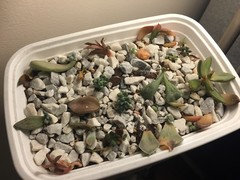
This is a shot taken after they have been repotted for a week. I'm surprised at how fast the new leaves emerged in this sedum burrito cutting such as short amount of time after moving it into the new pot.
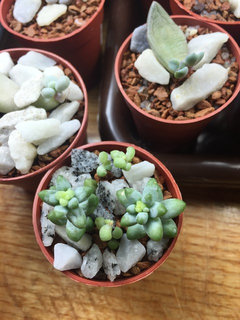
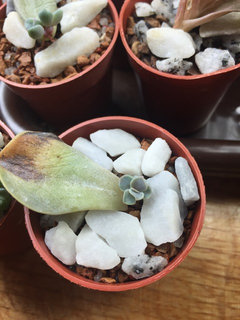
2) I definitely get that I need to cut down on my watering routine and I'm completely on board, but I just want to address the signs of dried up roots, because they are as much as a hindrance as overwatering to the progress of the plant's health.
This is an example, when Andy sent me this month about a month ago.. It's a E Agavodies Red Edge.


This was the amount of healthy roots it had when it was shipped to me and they were pretty well maintained when they arrived. (Unfortunately I don't have a pic of the roots)
I practiced caution watering with this one, know it doesn't have enough roots with such a big pot is an invitation to fungus/rot. But after a month, I keep seeing more and more lower leaves continue to fade. I got frustrated and lifted it up, almost all of the roots were dried and fried. I'm just puzzled why some are easier to establish themselves, while others are not?
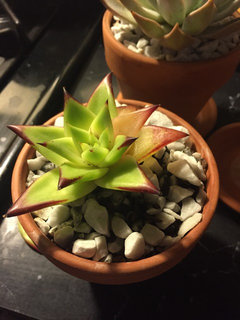

My point is, I'm not afraid to cut down on watering, but it's especially with these plants that I'm even more afraid of hindering their growth because of insufficient moisture.
I hope getting perlite will help me in my situation.
3) Rest assure, the plants that go up enjoy the fresh air + sun, wasn't a sudden reaction, but an ongoing process since the start of Spring.
On rainy or cloudy days, they all go straight under the grow lights.
Of course the more fussy and newer plants just sits by my windowsill in a SW facing window that catches about 3-4 hours of afternoon sun.

Interesting proposition on your bet there, but I just want to bring up an example on the smaller plants in the smaller terra cotta pots.
This is what happens when I watered it weekly. The wrinkly leaves worries me.
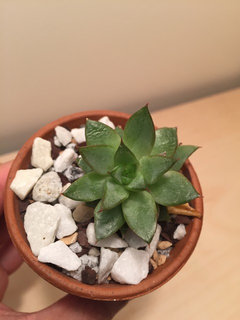
I'll post another shot when I get home to show it recovering.
Now I understand the bigger plants that have established roots can go longer without watering for weeks, even months and I'm all on board, but I still feel the need to address the smaller plants on dehydration and keeping enough moisture for their roots to establish.
Now the gollum plant did not just take one serving of watering to recover, it took a good week of watering, almost twice daily, before it started showing signs of recovery. Even now, the plant is still showing certain stress signs from the previous scenario of dehydration.
I'm not trying to be a difficult camper and insist that my is right, but I feel like finding balance, for example in watering is justifying both end of the extremes, address the issues that comes along with it and rectify. I'm not ready just yet to tip off the scale on stop watering my plants for a good month, until the problems of dehydration and burnt roots are addressed here. (Though if you are sticking to your bet, I might just take your word for it and sign up for the GM challenge)
*
I saw your post a little late, I had just bought another version before seeing your recommendation.
http://www.amazon.com/gp/product/B001V6WXEI?psc=1&redirect=true&ref_=oh_aui_detailpage_o00_s00
I'm sure it should work equally fine.
aztcqn
8 years agolast modified: 8 years ago" I think my whole point was for you to STOP watering every other day--or
even every week. If most of us who have our plants outdoors in full sun
in California or Texas water our GM plants every other day or go even
longer easily, then you most definitely should not be watering as often
or more when growing indoors...."I had the exact same thought!!! In Southern California (which is dryer than Northern Cali) in this 80-90 dryer heat, I don't water more than once a week. I feel bad when I see them in the heat (sometimes) but, when I check them, 98% of the plants are content and putting out new grow or leaves. Seems the more grey or fuzz on them the more sensitive to moisture retention they are.
Try sugi_c's challenge!!! DO IT. :]
I am most curious to see how you do.andy_e
8 years agolast modified: 8 years agoI think Grace is dead on.
Reading Al's posts led me to believe that 1:1:1 gritty mix would dry out a lot faster than it really does because he constantly talks about how he has to water his trees every day.
So far what I'm finding with C&S is that it stays wet for quite a long time. Perhaps this is because the root systems of succulents are smaller than those of broadleaf plants. This makes sense if you think about it because broadleaf plants lose water through their leaves so quickly that they need the ability to move a large volume of water out of the soil. Note that Al admits he doesn't have much experience with succulents...
Most of my plants in 1:1:1 are doing ok but none of them are growing robustly.
I'm going to cut back on the Turface to 25% or less (3:1 gravel/turface) and also experiment with a mix of just pumice and lava rock. I have a "troubled" echeveria in straight pumice and it's doing really well.
bernardyjh
Original Author8 years agolast modified: 8 years agoAlright guys! I believe it's time for me to start thinking up a watering intervention...
aztcqn
8 years agolast modified: 8 years agoHide the watering can, quick!
@Andy, I find the fussiest succulents do so well in 50% large sized pumice and de-compposed granite to bark fines. I don't ever filter the bark fines because the pumice keeps the mix very open. Plants thrive in it..... Mealies are still a big problem tho. I think I'm going imadicloprid... I've had enough.
If you need a source for the big perlite - think hydroponics/ "medicinal herb" specialized growing stores.....I found great stuff there.Neil
8 years agoI water my indoor plants (non-succulent) every week. I water my outdoor plants (succulents) once every 2 weeks including the summer. Cacti every 3-4 weeks in the summer/hot weater. hardly or if ever in the winter. Succulents get water in the winter if it doesn't rain..then, once a month. Each one has great drainage.
From speaking with others about watering, from what I gather..is that what works for me and my plants, may not necessarily work for someone else's plants.
I think for the most part and something we can all agree on (hopefully) is that there are rules of thumb and other areas that are still a bit gray.
When I give others advice and say "don't water it often," I forget at times that they REALLY don't understand what that means. "A little" could mean a squirt from a water bottle, a 1/2 cup or a gallon.
I think there is also some amount of hesitation to give specifics because a certain amount of fear too. You don't want to tell someone to water their plant 1 cup of water every 8 days. That's too specific. Both of these situations could bring very bad results to their plants and we would not want to be responsible for someone losing their plant because of bad advice on our part. I would feel quite badly about that.
Some...as their rule of thumb if they are ever in doubt about watering, they don't. It is always better to underwater than to overwater. Does everyone agree?
Sugi_C (Las Vegas, NV)
8 years agoAndy,
About 90% of what I wrote in this thread, I learned from Al, directly or indirectly when he's sharing info with the forum, and the remainder is basic common sense. A tree ain't a succulent; a cactus is not a fern, etc.
Just so we're clear. :)
LilBit7765
8 years agoBernard, everyone is just trying to help you.........and your plants. I live in Michigan, it has been a rather wet and overcast summer. I just put my plants out in the greenhouse. Not ALL but MOST are in GM. We are FINALLY getting sun. Yay! In my greenhouse where it is MUCH hotter, I watered once in two weeks. Im not sure weighing is working for you, not yet, you're still new to succulents. H3!! I still call myself a newbie (I probably ALWAYS will lol) the point is, I believe you are driving yourself nuts worrying about them SOO much, that in the process, you are "KILLING THEM WITH........TOO MUCH ATTENTION"
These are GREAT plants for people that love plants but really dont want to dote over them to much. They are VERY resilient plants. Listen to the saying "better to UNDERWATER than OVERWATER" its SOOOOO TRUE. I had leaves fall off a plant i purchased 4 or 5 months ago. I grabbed (what i thought was ALL the leaves, but i was wrong) two of them had rolled underneath the front passenger car seat and i found them while i was vaccuming. They both had roots and etiolated baby plants, BUT they were alive, and still are. NO water, NO soil, basically NO light. My point is PLEASE for your sanity AND your plants HEALTH, take Sugi's challenge! Your plants (and you) will be SOOO MUCH BETTER for it. I would totally scare you if I told you how long I went without watering one of my pachyphtums this winter! It flowered! I posted it in May Blooms, If i remember correctly. I hope what we're all saying is reassuring you, because if you keep on your path, I truly believe you wont you wont have any plants left. I'm not trying to be mean or anything, just trying to help. I know when I switched to gritty, i worried ALOT too, but I LISTENED to Al, Rina, Josh, Mike, and a few others that grew in gritty, took their advise, and now my plants are doing GREAT! (Except some that got etiolated b4 I got them outside)
Take the 3 WEEK CHALLENGE!!!! Remember, succulents go longer than that in the wild without water, you know that though, and you know that they have plenty of reserves in leaves and stems. Quit fretting! ;) good luck with your challenge, prove to us you can do it!!!
LilBit7765
8 years agoBernard, everyone is just trying to help you.........and your plants. I live in Michigan, it has been a rather wet and overcast summer. I just put my plants out in the greenhouse. Not ALL but MOST are in GM. We are FINALLY getting sun. Yay! In my greenhouse where it is MUCH hotter, I watered once in two weeks. Im not sure weighing is working for you, not yet, you're still new to succulents. H3!! I still call myself a newbie (I probably ALWAYS will lol) the point is, I believe you are driving yourself nuts worrying about them SOO much, that in the process, you are "KILLING THEM WITH........TOO MUCH ATTENTION"
These are GREAT plants for people that love plants but really dont want to dote over them to much. They are VERY resilient plants. Listen to the saying "better to UNDERWATER than OVERWATER" its SOOOOO TRUE. I had leaves fall off a plant i purchased 4 or 5 months ago. I grabbed (what i thought was ALL the leaves, but i was wrong) two of them had rolled underneath the front passenger car seat and i found them while i was vaccuming. They both had roots and etiolated baby plants, BUT they were alive, and still are. NO water, NO soil, basically NO light. My point is PLEASE for your sanity AND your plants HEALTH, take Sugi's challenge! Your plants (and you) will be SOOO MUCH BETTER for it. I would totally scare you if I told you how long I went without watering one of my pachyphtums this winter! It flowered! I posted it in May Blooms, If i remember correctly. I hope what we're all saying is reassuring you, because if you keep on your path, I truly believe you wont you wont have any plants left. I'm not trying to be mean or anything, just trying to help. I know when I switched to gritty, i worried ALOT too, but I LISTENED to Al, Rina, Josh, Mike, and a few others that grew in gritty, took their advise, and now my plants are doing GREAT! (Except some that got etiolated b4 I got them outside)
Take the 3 WEEK CHALLENGE!!!! Remember, succulents go longer than that in the wild without water, you know that though, and you know that they have plenty of reserves in leaves and stems. Quit fretting! ;) good luck with your challenge, prove to us you can do it!!!
bernardyjh
Original Author8 years agoWow, it's reassuring to know that you guys have such long periods (up to 2 weeks) of drying in between your waterings, even in the summer heat.
I just need some help to identify stress signs or some may call it signs of thirst and indications of the plants needing water.
I always have this fear of burning roots to crisp, and always thought these plants need some level of moisture to maintain healthy pink/white roots.
Here's a picture I took last night on the Echeveria cutting that I had recieved from Andy. No signs of new roots movement like when I received it, did I killed it by drying too long by underwatering? or that's just normal?
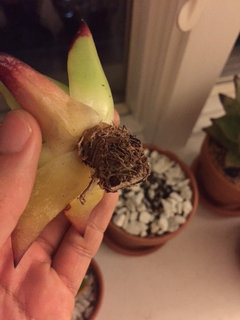
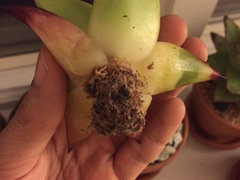
I thank everyone for sharing your experience, and I really do. I'm going to take a step back and observe how my plants will do when I take a chill pill.
But at the same time, I don't want to stop learning - so comments I hope I can get answers to my questions-
1) How to identify signs of thirst? How to differ them from stress signs after repotting?
- I know wrinkled leaves are one type symptom, but what happens if they dry up at an alarming rate like my variegated echeveria?
2) Burnt roots, or dried up roots, are they normal or they are signs of underwatering stress? I do know younger plants need a fair bit more moisture to continue maintaining root growth, else they just die off.
bernardyjh
Original Author8 years agoLOL GRACE!! I WILL, but why can no one address my questions?!
I know alot of growers here go by feel, but I would really like to know the reasoning and scientific explanation behind it.
LilBit7765
8 years agolast modified: 8 years agoBernard, you are making this WAY MORE DIFFICULT ON YOURSELF THAN IT NEEDS TO BE! LOL You need to stop pulling them out! Any root growth that they might have had is getting disrupted by you CONSTANTLY pulling them out.
Signs of thirst: if you havent watered in quite a while leaves will be wrinkly, not turgid. Aloes will have a softer feel, aka not as stiff and they wont be ready to puncture you by their pointy ends. Think of the look of a jade leaf when needing water. Im sure you saw Rina's pic of her gollum jade she missed watering, and it BOUNCED BACK!!! THEY ARE VERY RESILIENT!! Another reason you could be having problems with rot is you constantly ARE PULLING THEM out damaging roots and then watering them causing rot. Just an idea. Please LEAVE THEM ALONE! 3 weeks without watering........NOT GONNA HURT THEM.
Sugi_C (Las Vegas, NV)
8 years agoBecause it's so completely and wholly irrelevant to you.
When you're treating your plants like marine life, don't worry about what happens when your plant dries up on dry land.
in the meantime, yours have not even had time to grow or even root. I know you told me you put your plants on the roof but please make sure it's not the plants that have no roots. They will just burn up. You put a plant in full sun like the roof without any means of drinking water.....well you would not even last a day, never mind a plant. It's like putting a drowning person in boiling water and thinking it will be better. It won't.
EVERY TIME YOU LIFT YOUR PLANTS, YOU ARE BASICALLY REPOTTING IT. If it got to 1, you just took it back to 0. For the 10th time.
And then your question is about thirst! And then, to add insult to injury (and I had to laugh!), the next photo you post is one of you lifting your plants AGAIN.
You're killing me.
You are weeks away from thirst. I don't think you will make it to weeks before watering your plants so thirst is not of any concern. And with ailing plants, there is no way to tell what causes which symptom at this point, because you've completely messed them up at this point. If you die of cancer and I die of an aneurysm, when we're dead, we will both look equally dead. Just not alive at all.
AND BECAUSE THEY HAVE NO ROOTS, IT DOESN'T MATTER IF THEY ARE THIRSTY. THEY HAVE TO GROW ROOTS TO DRINK. And gotta get thirsty to grow roots.... This is totally oversimplifying it but do you understand?
Stop lifting them.
Do not water your plants.
And while I cannot speak to whatever healthy plants you may have, everything you have shown on this thread ---- get them out of the sun. They cannot survive on the rooftop right now and it's not a watering thing. Personally, if a plant has no roots, I don't put it in any sun until I see growth.
If I take out your lungs but then demanded you run a marathon (or live, for that matter), how would you fare?
kathi_mdgd
8 years agoSometimes when all else fails i just isolate the plant and leave it alone for awhile and when i go back i see signs of new life.Some times we can love them to death,just saying.My plants do better with neglect than babying!!!
Neil
8 years agoI am sure there IS a scientific reason but I could be wrong about that. Plants are living creatures, each uniquely different from one another such as we humans are. They have such subtleties we as humans probably could not recognize them in any of our lifetimes. And, this is where science would fail you.
The type of gardener who grows succulents for the sheer love of them tries his or her best to emulate the conditions where they are originally from and give the plant what it needs for it to flourish.
Most plants do not like being touched, examined, or uprooted. It may have an instinct to go dormant for fear it's about to be eaten by some animal. I think this is especially true when trying to root them.
I had a jade plant cutting I rescued from a very mutilated plant. I let the cutting sit in pumice for a little over 6 months. I was about to give up on it until I saw some new growth. Finally! During that entire time I did not move it or touch it for any reason, and that includes not giving it any water! It is much larger today and healthier than it's ever been.
My grandmother (god rest her soul) was a phenomenal gardener. She could grow anything and resurrect anything. She knew when to plant, when and how to prune, propagate, fertilize, you name it she knew it. Plants were her "thing." She was never on a "schedule" with her plants. She just seemed to know what they needed from her and when. Caring for them gave her such a fulfillment and joy in her life. At times I just thought she was "crazy." Of course, I don't feel that way now; quite the opposite. I think though, I figured out what she did, her "secret." She bonded with the plants. I don't think one could explain that scientifically. Hopefully she passed some of her intuitiveness onto me because i'm really not on a schedule with my plants either.
I don't know if you Bernard or anyone else has seen this video but, I will post a link to it here. It's on YouTube and about an hour long. I found it to be insightful.
Pat Z5or6 SEMich
8 years agoNeil, thank you so much for posting the BBC link. It was wonderful. How cool it is to learn new things, no matter our age. The internet just shines at times like these.
kaktuskris
8 years agoBernard, to be concise, you are overthinking things. You make it harder than it has to be. With watering, less is more. Trust me. Most of my plants are not even in gritty mix and they grow well, because through experience, I know when to water. And that is not very often. Good luck in the learning process.
Christopherbernardyjh
Original Author8 years agoGuys, I know everyone here have the best of intentions on my thread here with your advices and comments. But I really do feel like the assumptions made here are almost too quick at jumping at my throat instead addressing the issue.
Every course of action I had made here has a train of thought and reasoning behind it, but by solely harping only on the mistakes without asking or understanding my position on why I did them makes things extremely discouraging for me.
It really does make things twice as frustrated for me than it is for you.
I don't believe in a one method fix all problems solution, and that is the point of us here in this forum to share our mistakes, exchange learning thoughts and experiences (which I really value).
But personally feel like it has reached the point where "it's my way or it's no way" and this dismissive approach on all my actions just fuels my frustration even more. I'm left with the problems I started out with, unanswered and to deal with them on my own. My next point of action is either follow a one step advice which was given with only limited information that was given on this thread without any further understanding to the needs of my other plants, or stick it out on my own and struggle with the learning curve by trial and error.
Now moving onto clearing the issues that I felt like I was misunderstood:
- On the issue of the Echeveria that I lifted up - it was never truly potted into a pot to begin with. It had such a small stem, I had just laid it on the surface of the mix with some top soil securing the plant.
The reason for checking on the roots, was when I noticed an alarming rate of lower leaves drying up, similar to the other ailing E. black prince that had rot/fungus which prompts me to do a quick check on the roots.
I DON'T lift plants up for fun, and I know how devastating it is to the roots whenever that is done. So I'm feeling equally frustrated at all your accusations of me destroying my plants.
I admit that I am giving my plants more attention than before and you have to put yourself in my shoes to go through my train of thought too. It's because of that "neglect mentality" that I gave my plants before this post and not being vigilant enough to catch the rot happening earlier on my other 3 Echeverias is what that had led me to my loss now.
I KNOW succulents are very robust and tough plants, but when your plants show signs of changes or even stress, I believed they need to be addressed in a methodical cause of actions.
Gently touching them is my first step, and when it wobbles or have mushy bottom leaves (or leaves drying up at alarming rates - all 5 leaves at once), more drastic measures needs to be taken to inspect the health. For this particular Echeveria, I started removing the dried up leaves, and it was so frail that the entire plant lifted along with it, and it is then when I realized almost all of its healthy roots are completely dried up. (which still left me with no answers on damaged roots by underwatering - I highly doubt the plant is going dormant) I merely lifted the plant for a picture the day after (the plant was already had no anchored roots and was filmsy sitting on the top soil) to show you my point - underwatering.
Which brings me back to same my question about underwatering - how much is not too far that you can push the plant in the GM?
2) Roof - PLEASE STOP ASSUMING I'M DECIMATING ALL MY PLANTS BY BLASTING THEM WITH NON-STOP SUNLIGHT IN THE ROOF BY AN OVERNIGHT THOUGHT. Please! Plants that go to the roof are only established plants and not those without roots or I believe that are still growing and establishing themselves.
The roof is a luxury for some plants that I believe can take more sunlight and increased air flow. These plants have already been acclimated long enough so they don't discover the shock of intense sun and be burnt.
The rest of the plants, including all the ailing ones posted here sits by the windowsills.
On rainy days, all plants go under the growlights.
3) Light - Grace, I would like to quote you on this one
"As mentioned, indoor sun is never, ever going to truly burn your plants short of putting them up smashed against a window if they are healthy and accustomed to that level of sun."
I've followed your advise and cut my waterings on ALL my plants, and I would really beg to differ on your statement on specific plants. I returned home today to see my variegated PvN with the last of its remaining fairer colored leaves burnt, and they have only been sitting on the windowsill all this while. My thought is that variegated plants generally are more sensitive to light and need watering more often than regular plants, else they crisp up and dry up much faster than regular succulents.
These burnt marks were previously not there, and from my experience, this guy is very prone to burnts, and goes thirsty very quickly because of how little roots it had when repotted.
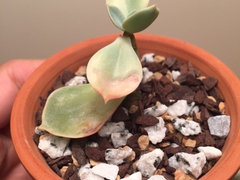
4) Signs of Thrist -
Lilbit, I know wrinkling leaves are one symptom. But stress colors worries me too. Remember these guys?
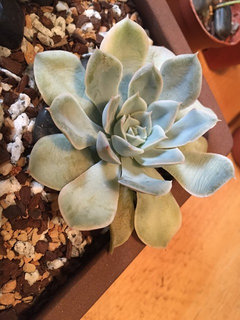

These were taken 2 months ago, repotted in GM for a few weeks and were only watered sparingly compared to my current watering schedule.
Here's them now.
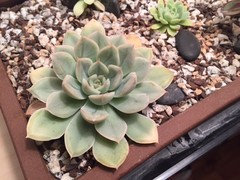

Notice those white shades on the bottom leaves? They were never there last week. But after this week when I stopped watering. Those dastardly variegated colors returned. Note, lighting has never changed. They get the roof sun when weather permits, because I know how well they do with more sunlight and also how they have grown so much bigger in the community pot, which means their roots are established now and need more water, or at least they are seeking more. The 2 small ones that rotted were in this same pot, probably didn't react well enough as these 2, because in my eyes these big ones are thriving - they are firm and sturdy when nudged and their foilage speaks for itself. Anyway, when I removed the rotted babies, I noticed one of this big Echeveria roots were reaching into the space of the smaller Echeveria. (NOTE: DO NOT ASSUME, the small echeverias in the background are new smaller echeveria that I added into the community pot a few weeks ago, so ignore them)
My point is, are those stress colors healthy for the plant? Or is it hindering the plant's active growth and is it working twice harder to grow now because of the lack of water? Questions questions - which brings me to my case, I have more plants now, and every plant is a different scenario of its own. We can go for days talking about my plants problems (and I don't mind sharing them, but most of them can be fix rather easily by adjustments), which brings me back to the point that cutting watering should and will work on plants that are ailing or are indoors that are establishing themselves, but I don't think that plan will work for all plants.
Thoughts? I remember your plants showing those signs too, did they recover? Mine certainly did, with more water and light, the foilage stays well.
Neil - Thanks for the video, I only got into 10 minute of it and I'll watch the rest later.
Here's an excerpt by Al on petting plants, you can read the rest of the thread here - it's also by another fellow forum member dealing with adapting to the gritty mix:
"Don't be too hard on yourself. Petting your plants, especially houseplants, isn't necessarily a bad habit. It can have a positive effect on them because it stimulates a thigmomorphogenic response. Even more effective than petting them is to scrub the stems and leaves lightly with a dry tooth brush. The light abrasion stimulates the production of ethylene gas, which in turn stimulates production of lignin - a part of all plants, but better known for being the natural polymer that makes woody plants woody. More lignin = a stronger plant and one more resistant to insects and disease.
In addition to natural senescence, the shedding of lower leaves can be associated with a number of causes. Tight roots is a big cause ..... also, mites, under-watering, over-watering or soil compaction, a high level of dissolved solids in the soil solution, and light issues.
Plants are usually better able to adjust to increased photo load (over time) than a decrease in light, but the ability to adjust in either direction isn't unlimited. Just as an illustration: If we imagine that a new leaf appears on a houseplant under light conditions of 5 on a 1-10 scale, that leaf might be able to adjust, gradually, to a level of 8 on the brighter side, but maybe only a 3 or 4 on the dim side before the plant's internal chemical messengers help it "decide" to shed the leaf because it's unable to adjust to the new light environment."
On and all, please do not take my response the wrong way and I am by no means attempting to discredit your knowledge and experiences, nor am I going rouge here to contest everything you proposed.
From all I learnt, what works extremely well for you might not be the best for me. But think, logically, when someone does something, he has his reasons - ask why, address that problem that he is facing and attempt to change that thought by working on that problem and not force feed a quick fix solution.
I know reducing my water frequency is going to really help alleviate the problems of damp soil/fungus and rot, but that doesn't help the plants that are suffering from crispy roots and stress.
I know adopting the "neglect mentality" will ultimately benefit most of my plants, but how do you know when it is the right time to catch the problem?
- Bernard
bernardyjh
Original Author8 years agoThanks Chris, perhaps I am. And I don't mind going the extra step if it takes to help me learn. It's just experience and learning the right balance at watering is all that it takes to beat that learning curve.
kaktuskris
8 years agoYou are still overthinking it, sorry if I am being too forthright in saying so. When to water? Simple answer, When it doubt, DON'T! I killed my nice Jade years ago before that sunk in, and now they thrive.
Christopher
LilBit7765
8 years agolast modified: 8 years agoThe plant you mentioned (MY PREVIOUS PROBLEM CHILD LOL) was Echeveria opal moon. My problem (which I didnt notice right away because of working ALL THE TIME) was that I hadnt noticed that the lighting had changed SOOOO much. You'd think South window= best indoor window. But where this plant was situated (even though it was close to the window) it sat lower than where the sun rays used to reach. So it was starving for light and was dropping leaves at an alarming rate. It wasnt until I had a day off that I realized this, now that the plant is outside, its coming back. Bernard, we really are just trying to help you, but now reading your last post (or 2nd to last) i have questions.
1) your community pot, when has it been outside? How often? Were there any days skipped? If so, how many? Where are they kept inside? To me, I really dont see anything to worry about, they look great, healthy
here in Michigan, it has been VERY overcast, rainy for most of the season. Now the last few days have been blazing. Has it been over cast there? Whats the roof like? Roofs are generally hotter than (you know). Plus if i rememver correctly, its pretty high up.
2) the plants that are burning inside your apartment, where are they? If by a window, wheres it facing? Do they have roots? Does DIRECT sun come in? How long have you had them? How and where did you obtain them?
I still think the best way for you to water in the gritty at this time, until you get use to it, is by inserting a wooden dowel in the mix leaving for around 10 minutes then touching it to your cheek or inside of your wrist. It AMAZED me how much moisture it really held.
now to tell you about some more newbie mistakes I have made with gritty mix. I had a beautiful crocodile aloe. Full, full of pups, it was doing GREAT. Then i moved it to gritty. It rotted in two or three days if i remember correctly. My mistake, i took the "you dont have to worry about rot with this mix from over watering, and i guess in my mind that meant ok if i didnt even water it, it should be fine. Well i was WRONG.WRONG WRONG WRONG. I premoistened my mix by rinsing EVERYTHING like we're supposed to. And soaked the bark. Well the crocodile aloe was in a heavy soil, basically NO perlite, so i had to thoroughly clean the roots, ofcourse im sure i damaged the h3!! Outta them. Then i put them in a premoistened batch of gritty, which i thought wouldnt be a problem. :( it started with one pup, then the whole thing was one collapsed pile of mush. I was heartbroken. But that unfortunatley wasnt the only one, before this, there were two other pots full of christmas carol aloes. I had done the same to them. I was thinking that gritty wouldnt rot my plants, but if you put newly cleaned roots that youve not allowed to calluss over into premoistened mix it sure will. I was afraid to do ANYTHING to ANY plant in the mix for quite awhile, but like i mentioned earlier in your thread, i got help from some VERY KNOWLEDGEABLE folks :)
I hope my babbling has helped you in some way. I still think you need to chill out though lol! Youre gonna get yourself discouraged, and wanna give up. And you have to understand, that there are some plants that youre just not going to be able to grow NO MATTER WHAT YOU DO. We ALL have our "plant" or "plants" that NO MATTER what we do, we kill them. And you please have to remember also, that some of us dont get into all the "scientific" jargon.......we just like to grow plants. Like Neil mentioned, some are just intuned and have a "NATURAL" green thumb. They can look at their plant, and know what it needs, while others, learn by trial and error. The longer youre with your plants Bernard, the more youre going to be able to tell what they need.
And you also have to take into account everyones growing conditions are going to be different than yours. And vice versa. They might be able to give you a few ideas to look at, but in the end, youre the only one whos going to be able to test it out. Get what I'm saying? Hope this helped. :)
ewwmayo
8 years agoBernard, just wanted to chip in my success and failures on moving succulents indoors and out. With my light meters and data logs, maybe I have something interesting to add? I've included lots of photos to show my findings, so hopefully you don't mind. =)
Growth from moving my plants outside on my roof in the evenings was so good that I'd be excited to get home from work, just to put my plants out. Direct sun was no problem, as long as it was after ~5:00pm (Zone 6a near Toronto, Canada). Each evening light 'trip' would shorten watering frequency by a day or so. My Euphorbia trigona was growing nicely just from the two tops, but now it's growing nicely from ALL arms.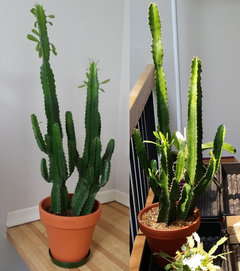
My succulents went from a DLI of 3 (indoors) to a DLI of 5 (indoors + evening outside) without any issues whatsoever. With just one day of a DLI of around 16 (outdoors all day or 2pm+), my aloes/euphorbia/jades all burned. Aloes took several weeks to recover, Jades about 1 week and some large leaves were lost.
Tested this twice, same results. Admittedly, it was kind of stupid to do so, but I know now what most of my plants look like as they are dehydrated/sunburnt/slowly dying.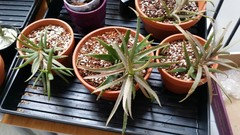
I built a new outdoor growing setup with a white board on the very top shelf (of 4) for noon-time shade. With a new DLI of 11, my aloes now burned slowly over a couple days. Hooray? Jades did exceedingly well, as were all my other succulents. My Echeveria elgans has very tight and compact new growth. My Haworthia resendeana burned very badly, while my other Hawthorias just looked stressed. Here is my Crassula aborescens' growth over one month.

Not sure if you have any Gasteria, but they do very well at slightly shaded (DLI 11) rooftop light too! The pups have doubled in size in a month. So if you have any, there is nothing to fear moving them to the roof for much of the day. =)
Adding some white laundry bag mesh (30% shade, based on fc measurements) on the two most exposed sides for the top shelf helped my lower light plants. DLI on this extra-sheltered outdoor shelf is now 5.6. Only my very small aloes burned and my Haworthias looked much better.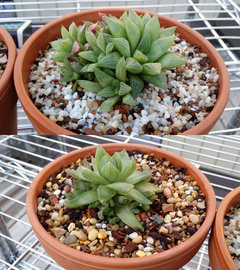
Almsot every day, I go and look at my plants now. THINGS ARE CHANGING! A very cool day after a very bright day is always the most interesting. My succulents are always showing new growth when this happens. Nearly all my mesembs are growing, even in the summer. I really love watching these two, my Cheiridopsis pillansii and Gibbaeum dispar.
Of course... not everything is doing stellar. I'm still struggling with my Titanopsis calcera and replacement Faucaria felina. My once pristine Haworthia resendea is permanently disfigured, but at least now it's stabilized.

I think I watered my Titanopsis too often and many of its leaves are yellowing/shrivelling up, while other leaves are growing quite nicely (confusing!!). The Faucaria is newly repotted and is clearly stressed - the roots can't keep up so some leaves are shrivelling. But I don't want to overwater and turn it to mush!
Anyway, it seems like you mostly grow Echeveria and Sedums, but hopefully this helps at least a little! It was painful to post about my other plants I've lost this summer, but my hope is at least others can not repeat my blunders. I've honestly learned so much more from other people's "failed" plants than their successes.Which I think is the whole idea behind this thread. ^_^
bernardyjh
Original Author8 years agoChris, lilbit and mayo - I'm really glad you guys are all sharing your bit of failures here too. It takes courage to share them, mistakes and heartbreaks. Though painful, but it might all help save another person from going through the same ordeal.
lilbit, I'll sit down and do a write up for all your questions tomorrow. It's bedtime for now.
Neil
8 years agoWow, this has been a "heavy" and heated thread! So, allow me to lighten it : ) Remember, we're all friends here ; )

aztcqn
8 years agolast modified: 8 years agoHi, Bernard, When to water may not be the sole factor in the issues you're experiencing with some of these plants. One thing that comes to mind is the temperatures in the windows. Even if light is low, but the temperatures are high, a window can really build up heat. Especially bad is little or no air circulation. Something about glass and heat that can cook plants if temps are not controlled. This may be why plants are crisping out even though you're watering. I don't recall what your situation is indoors.
And for everyone:
I'd definitely know what to do with these succulents!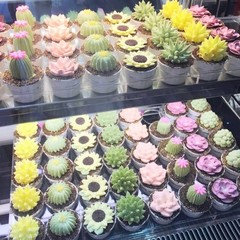
bernardyjh
Original Author8 years agoLilbit, when you get the chance please share some pics of your oplina moon aka problem child lol
QnA
1) your community pot, when has it been outside? How often? Were there any days skipped? If so, how many? Where are they kept inside? To me, I really dont see anything to worry about, they look great, healthy here in Michigan, it has been VERY overcast, rainy for most of the season. Now the last few days have been blazing. Has it been over cast there? Whats the roof like? Roofs are generally hotter than (you know). Plus if i rememver correctly, its pretty high up.
The community pot and a few other plants that I started with were slowly acclimated to the roof on a daily basis since the start of May.
They go up when it's sunny. At the least I leave them towards a corner that usually gets shade right after noon time. As the days gets longer, they shade sits in later. Now they go to another corner that gets partial shade in the morning, and all day afternoon sun till sunset. I particularly love the coloring on my jelly bean plants, and are offsetting which is a pleasant surprise. (Though they got slight burnt tips from the transition)
There are definitely days skipped. There was one week we had a storm and rainfall for almost the whole week, so they come back down and go under the grow lights. About 5-6 to the lights, 6500k compact fluorescent lights for about 12-13 hours.
My concern was never them to begin with, with the exception of the 2 seedlings/ or I still considered babies, that rotted because of my heavy handed watering due to a dry and sunny week through transitioning them to more sun. - which is why I'm thinking of bringing back the scale method before watering, because it's absolute where you know when the plants gets really thirsty (they get really light in weight) and you can time the duration they go without water. it's just a little time consuming because I have so many plants now.
The roof sits on the 10th floor, light gets intense, but only selected plants that I know can withstand and enjoy more light goes up. Like I said, it's only a luxury. It gets really windy too, but the wind helps the plants anchor themselves more to the mix, making them much much more sturdy than my plants indoors.
2) the plants that are burning inside your apartment, where are they? If by a window, wheres it facing? Do they have roots? Does DIRECT sun come in? How long have you had them? How and where did you obtain them?
All plants indoors sits in my bedroom windowsills, facing SW. We used to have longer days of sun in the Spring, but now with the day more spread out, direct sun only comes in from 1-5, about 4 hours and are staggered because they fold into the west moving motion, which I believe is still sufficient for the plants and maybe a little hot depending on the temperature.
Roots wise, all of them have roots, but are definitely not established yet. And you can tell as some are still wobbly in the pots.
This part is a little trickier. Most of plants that I'm facing problems with are all new acquisitions, some bought online (ebay), some we from other forum members. I believe stress signs are way of telling me they had their new home, and soil too. lol The variegated black prince was from poland, compton carousel from france. My toughest job now is (with my limited knowledge on the GM) to keep up and predict their needs. which brings me back to the point on stressed plants - when heat rises, do we water more to help its roots cope? And they all had been given a grace period to rest for 3-5 days (which means no water, no direct sunlight - just shaded sun in my living room) ) after potting before they were placed on that window.
I still think the best way for you to water in the gritty at this time, until you get use to it, is by inserting a wooden dowel in the mix leaving for around 10 minutes then touching it to your cheek or inside of your wrist. It AMAZED me how much moisture it really held.
You see, this method works if the pot is big enough, or on bigger plants. But when the plant and pot are small, there is very little leeway to dip the stick into the mix without disrupting the roots/mix. This is why I started weight them, and my digital scale has a volume option which really helps when it comes to measure how much water content there is.
I never pre-moist my mix when I repot plants, only the other day when I lay those leaves on the nursery trays (one GM and one turface), which was a mistake.
I believe most of my plants that are in the regular 4 inch (or smaller) terra cotta pots NEVER have any problems with rot or fungus despite my heavy handed watering. It's only the more special pots, like the community pot - and the large terra cotta pot (i think it was an 8 inch) for the variegated black prince that fell victim. It was a painful lesson, but pot types and sizes do play a part in retaining moisture. In fact, the smaller terra cotta pots for my seedlings are alway dry - that's why I experimented with more turface to up the moisture level (is working well for me thus far)
Like I said, there is no one size fits all. Even if so, some plants are more temperamental and needy than others. For the most parts, my plants are happy and I really do enjoy watching them with less attention. Some even rebloomed, which was a great surprise for me, having only been growing them for a few months now.
I'm sorry to hear about your Crocodile Aloe, and I'm reassured to know that killing plants is a part of the learning process for everyone (not saying we all go out and kill them now, but through painful mistakes)
Mayo - I'm glad you are experiencing levels of success with some your plants gaining the extra sun exposure from your roof/balcony
Quick question, what is DLI? Direct Light Index? Do you actually have a scale to measure light?
I know for a fact Haws aren't big fans of direct sunlight, if any they do the best with filtered light/more shade. I have a haw that just sits in the living room coffee table, and we get alot of shade from the trees outside. It has probably gone dormant, no water for the 2nd month now and I won't disturb it until the weather cools down and it's time for a repot.
Unfortunately, I don't have any Gasteria, I think it will work great for an apartment that doesn't get much sun (like david's).
You are spot on, I'm a big time sucka for Echeverias and Pachy too. I have a few kalanchoes, crassulas, sedums and dapping my feet into a few small catci here and there and no mesmerbs yet. I was thinking of ordering some seeds from mesa garden and start a fun project when the fall begins.
I'm sorry to hear about your titanopis, I hear that they are almost like an advance level of plants, because mesmerbs have completely opposite dormancy range as compared to regular cacti and succulents. On in all, I really appreciate you sharing, and it certainly does help!
Neil - We can always count on you to lighten up the mood!!
Azt - Those cupcakes are SOOO CUTE!
I agree, my windowsills can get really hot on summer afternoon. I think I might need to have the fan turned on when I leave for work, just so for air circulation. Maybe that will help and prevent cooking from happening.
On rainy days/ all plants go under the growlights.
Sugi_C (Las Vegas, NV)
8 years agoWhen you quoted me, Bernard, you should note that I said "healthy plants." Nothing about the plant you posted to disprove my point that they would get burnt was healthy.
Healthy plants, already accilmated to a windowsill indoors, do not burn from the sun they receive at that window short of sticking it on the window.
You also wrote the following to me:
"For starters, I'm taking the chill pill. Not moving my plants, I just left them on the roof. No extra watering routine."
And my assumptions, based on that, are you left everything out there. Then you clarified not the one without roots. Then you said they were already adjusted to the sun and heat up there.
But my point is that in this thread, it seemed you intermittently took your plants up there, which is not accilmated, but simply exposure to a massively different level of light.
I'll refrain on commenting on anything else in regards to your plants. Best of luck.
andy_e
8 years agolast modified: 8 years agoA couple of thoughts:
Leaf burn: I don't grow succulents indoors so I don't know what conditions will burn them, but I've definitely burned houseplants indoors from having them too close to the window. I don't know if that's a sunburn or something else on your variegated PVN but if that plant is having problems I'd keep it out of direct sun.
"Stress colors": I don't think what you're seeing on that light-colored echeveria is a stress problem. It looks very healthy to me. My advice would be to continue to be disciplined about letting it go dry and not worry about it being stressed. You're not going to kill it from underwatering.
The E. agavoides I sent you looks like it got too much water. The lower leaves rotting is a classic sign, as are the shriveled roots. I'd set that on some flat surface where it gets bright indirect light and in 3-4 weeks you should see new roots.
Al's recommendations: Keep in mind that most of what Al says is directed at growing leafy plants and may or may not apply to succulents. Succs have a different type of metabolism so not everything he recommends will work. I'm not saying to categorically ignore everything he says, just adding a caveat.
bernardyjh
Original Author8 years agoGrace - I believe there were some confusion about about our communication some way down the line. The plants mentioned here were never brought to the roof, in fact I had more plants than to the ones that has been posted in this thread.
Anyway, I do value everyone's comments including yours, but I felt I was being shamed for doing something that isn't accurate because of assumptions and the lack of communication frustrates me.
No ill feelings, I hope we are cool?
Thanks Andy, I always love your methodical approach and going straight to the point. I'm going to put the variegated Pvn away from direct sunlight (windowsills) until it picks itself back up.
So far, I've only experienced leaf burnts on these variegated plants. None so for any that has been growing indoors. I think Laurent had mentioned before that they are more prone to burning during the summer in high heat.
I didn't know shriveled roots is a sign of over watering. I think Grace is right, I must have over compensated the plant with more water thinking its roots is dry, and ironically its the water that caused it.
It's hard to swallow, but the lower leaves are a little translucent, should I remove them? Or just leave them as it is, they seem to be falling off really easily.
andy_e
8 years agoWhen they get translucent like that I remove them as soon as they're loose enough to pull off.
ewwmayo
8 years agoBernard, DLI stands for Daily Light Integral. Foot candles is an instantaneous measurement of light, which is helpful for humans working but not plants. DLI is how much PAR (useful for plants) light is received over an entire day. As a guideline, 0% Shade = 18 DLI, 25% Shade = 12 DLI, 50% shade = 6 DLI, 75% shade = 3 DLI. I have one with my succulents, one in my front yard, and one in my living room with my trees.
Does your Haworthia get etoliated on the coffee table? If you don't mind posting a photo, I'd love to see it. Appreciate the tips for that. I almost bought a beautiful Kalanchoe, but when I went back to the nursery the next morning it was gone! Bah. Hopefully I can turn my Titanopsis around soon. =)
I definitely find repotting and re-establishing new plants the hardest, especially if I've never grown that species before. Slowly, I'm getting better at distinguishing between new plant stress, lack of roots, dehydration, or too much light.
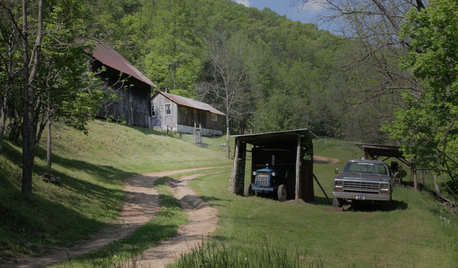


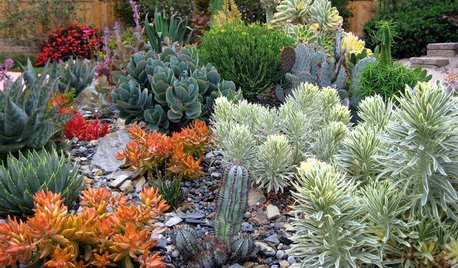
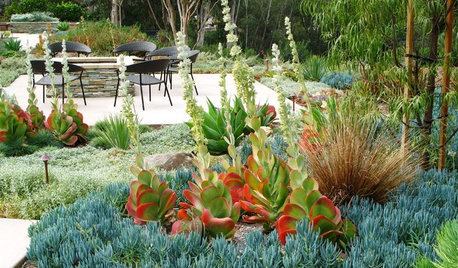
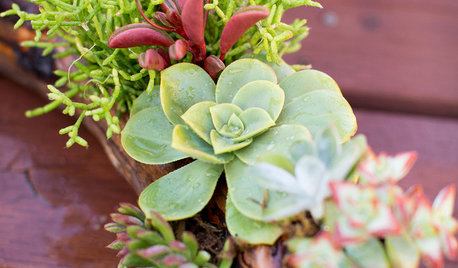
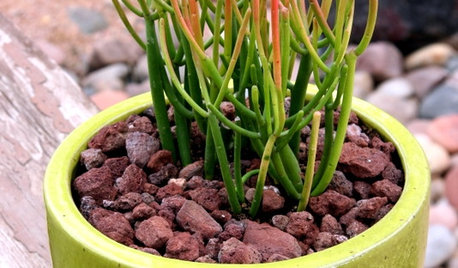
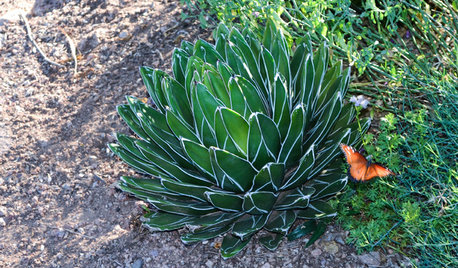
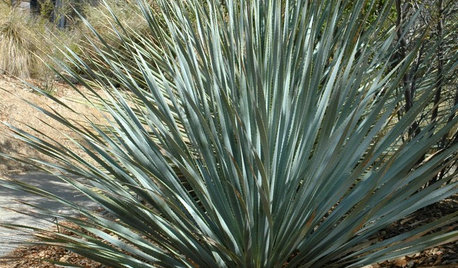
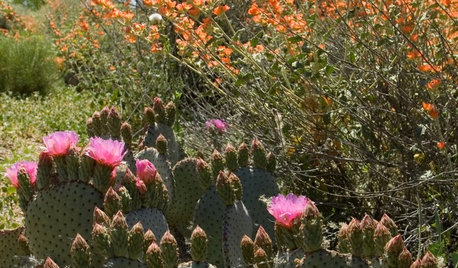




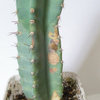
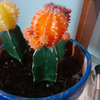
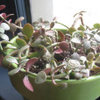
Sugi_C (Las Vegas, NV)